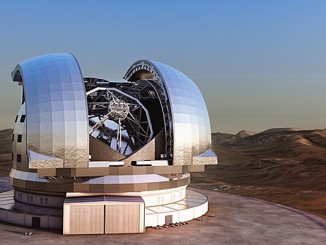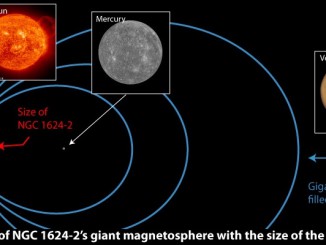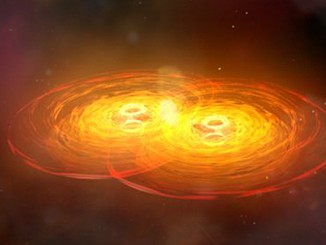
News


Modest-mass galaxy hosts oversized black hole: an evolutionary missing link?
The central supermassive black hole of a recently discovered galaxy called SAGE0536AGN is far larger than should be possible, according to current theories of galactic evolution. The galaxy was found by accident with NASA’s Spitzer space telescope and is thought to be at least 9 billion years old. Time will tell whether SAGE0536AGN really is an oddball, or simply the first in a new class of galaxies.

Surprising chemistry seen in molecular rings around young star
Astronomers using the Atacama Large Millimeter/submillimetre Array (ALMA) have discovered two spectacular rings of molecules encircling the young, Sun-like star IM Lup. The rings are made up of one of the most common heavy ions in space — DCO+ (deuterium, carbon, oxygen). This chemistry reveals new insights into the conditions of the planet-forming disc surrounding this star.

Unlocking the secrets of the universe’s brightest galaxies
The brightest galaxies in the universe, known as submillimetre galaxies (SMGs), aren’t visible to the naked eye. But look through an infrared telescope, and they light up the sky. They are probably 12 or 13 billion years old, and what makes them so luminous is that they form stars very quickly — 1000 times faster than our Milky Way. Now researchers have the first viable model of the origins of SMGs.

UK scientists seal deal on European Extremely Large Telescope’s first-light spectrograph
UK researchers have just signed an agreement to lead one of the first instruments for what will become the World’s largest visible and infrared telescope, the European Extremely Large Telescope (E-ELT). The spectrograph, called HARMONI, will provide the European Southern Observatory’s telescope with a sensitivity that is up to hundreds of times better than any current telescope of its kind.

Hot, dense material surrounds O-type star with largest magnetic field known
O-type stars are the hottest and brightest stars known. NASA’s Chandra X-ray Observatory has revealed that the magnetic field at the surface of NGC 1624-2 is 20,000 times stronger than at the surface of our Sun. NGC 1624-2 contains a raging storm of extreme stellar winds and dense plasma that gobbles up X-rays before they can escape into space.

Radio telescopes could spot supersonic stars hidden in the galactic centre
The centre of our Milky Way galaxy is a mysterious place. Not only is it thousands of light-years away, it’s also cloaked in so much dust that most stars within are rendered invisible. Harvard researchers are proposing a new way to clear the fog and spot stars hiding there. They suggest looking for radio waves coming from supersonic stars.

Pairs of supermassive black holes in galaxies may be rarer than previously thought
There may be fewer pairs of supermassive black holes orbiting each other at the cores of giant galaxies than previously thought, according to a new study. When two massive galaxies harbouring supermassive black holes collide, their black holes ultimately combine — a process that could be the strongest source of elusive gravitational waves, still yet to be directly detected.


Astronomers identify a new class of medium-sized black holes
Nearly all black holes come in one of two sizes: stellar mass black holes that weigh up to a few dozen times the mass of our Sun, or supermassive black holes ranging from a million to several billion times the Sun’s mass. A team led by astronomers at the University of Maryland and NASA’s Goddard Space Flight Center has found evidence for a new intermediate-mass black hole about 5,000 times the mass of our star.
